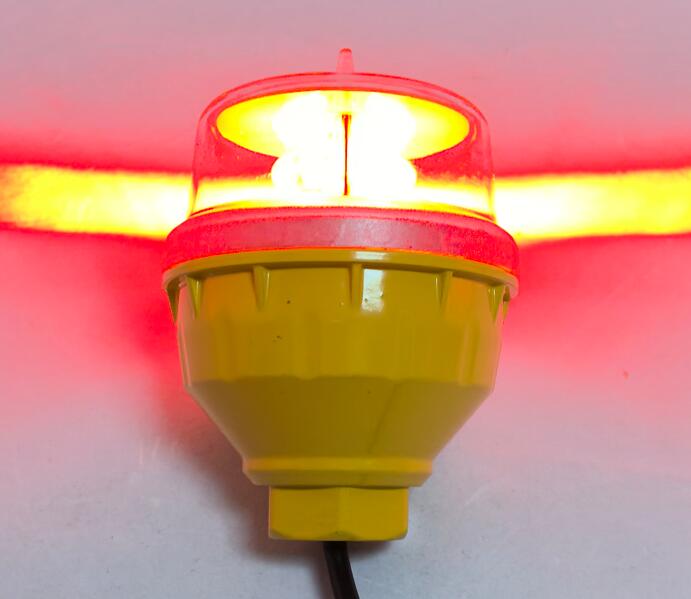In the complex network of aviation safety systems, the L-810 obstruction light plays a critical yet often understated role. Designed specifically for structures under 45 meters (148 feet), these compact but powerful lights serve as vital visual markers for low-flying aircraft, ensuring safe navigation around buildings, cranes, and other potential hazards.
As urban landscapes grow denser and renewable energy infrastructure expands, the importance of reliable L-810 obstruction lighting has never been greater. This article examines the technical specifications, applications, and evolving technology behind these essential safety devices.

Understanding the L-810 Standard
The L-810 obstruction light is classified under FAA (Federal Aviation Administration) and ICAO (International Civil Aviation Organization) regulations as a low-intensity red light. Key characteristics include:
Steady-burning operation (non-flashing)
Peak wavelength of 625-635nm for optimal visibility
Minimum light intensity of 10 candela
| l-810 obstruction light |
Horizontal coverage of 360 degrees
These specifications ensure the lights are clearly visible up to 3 nautical miles (5.6 km) under normal conditions, providing adequate warning time for pilots.
Critical Applications of L-810 Obstruction Lights
1. Urban Construction Safety
With the global construction boom, temporary L-810 lights protect cranes and partially built structures. Their compact size and durability make them ideal for mounting on moving equipment.
2. Renewable Energy Infrastructure
Smaller wind turbines and solar arrays (below 45m) increasingly use L-810 systems to meet aviation safety requirements without the need for more powerful lighting.
| l-810 obstruction lights |
3. Telecommunications
Cell towers under the height threshold benefit from the energy efficiency and reliability of modern L-810 LED solutions.
4. Power Transmission
Power lines and substations in flight paths utilize these lights to mark potential hazards without causing light pollution to surrounding communities.
The LED Revolution in L-810 Lighting
Traditional incandescent L-810 lights are being rapidly replaced by LED versions offering significant advantages:
90% energy reduction compared to incandescent models
50,000+ hour lifespan versus 1,000 hours for filament bulbs
Instant on/off capability with no warm-up time
Superior cold weather performance (operating down to -40°C)
Vibration resistance crucial for construction applications
Modern LED L-810 lights also feature:
Photocell automation for dusk-to-dawn operation
Corrosion-resistant aviation-grade aluminum housings
Optional flashing modes for enhanced visibility when needed
Installation and Compliance Considerations
Proper installation of L-810 obstruction lights requires attention to:
Mounting Height: Typically at the highest point of the structure
Spacing: Multiple lights may be required for extended structures
Visibility Angles: Ensuring unobstructed 360° coverage
Maintenance Access: Easy servicing without compromising safety
Regulatory compliance involves:
FAA AC 70/7460-1L (U.S. standards)
ICAO Annex 14 (international standards)
Local aviation authority approvals
Emerging Technologies in L-810 Systems
The latest innovations are transforming L-810 obstruction lighting:
1. Smart Monitoring Systems
Wireless connectivity for remote status checks
Automated failure alerts to maintenance teams
Cloud-based compliance tracking
2. Hybrid Power Options
Solar-charged battery systems for off-grid locations
Energy harvesting from wind or structural vibration
3. Advanced Materials
Self-cleaning hydrophobic coatings
Impact-resistant polycarbonate lenses
Graphene-enhanced heat dissipation
The Future of Low-Altitude Obstruction Lighting
As technology progresses, we can expect:
Integration with urban air mobility systems for drone corridors
AI-powered adaptive brightness based on real-time air traffic
Miniaturized designs with enhanced optical performance
Blockchain-based maintenance records for regulatory compliance
The humble L-810 obstruction light represents a perfect marriage of regulatory necessity and technological innovation. As our built environment becomes more complex and airspace more crowded, these unassuming devices will continue to play an outsized role in preventing accidents and saving lives.
By embracing LED technology, smart monitoring, and sustainable power solutions, the next generation of L-810 systems will deliver even greater safety benefits while reducing environmental impact. For any structure below 45 meters, proper L-810 obstruction lighting remains not just a legal requirement, but a moral obligation to protect those who navigate our skies.